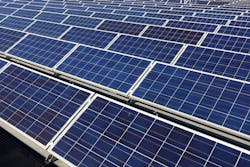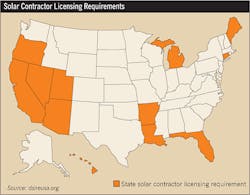In some ways, 2012 was a turbulent year for the U.S. solar photovoltaic (PV) industry. It weathered cuts in government incentives, unfair trade practices by international module manufacturers, and a weak global economy. Yet, with 684MW of PV capacity installed, third quarter 2012 marked the third largest on record. Total installed capacity through the first three quarters of the year reached 1,992MW, already surpassing 2011’s annual total of 1,885MW. In its “U.S. Solar Market Insight Q3 2012” report, the Solar Energy Industries Association (SEIA) was expecting an additional 1,200MW of PV capacity to be installed in the fourth quarter of 2012 alone, bringing the total for the year to 3,200MW.
This amount of installed megawatts provided generous business opportunities for solar PV installers in an otherwise sluggish construction economy. However, some solar integrators in the Commonwealth of Massachusetts say that for the last four years they have been prevented from taking advantage of that growth in the domestic solar industry. They claim stringent and unnecessary electrical licensing requirements for solar PV installations keep them from soliciting and performing installations in their state.
In an unprecedented step enacted on Jan. 30, 2009, the Massachusetts Board of State Examiners of Electricians (BSEE) passed a ruling requiring all aspects of solar electric installations to be performed by a state-licensed electrician. The BSEE based its ruling on commonwealth law, which states that anyone who installs “wires, conduits, apparatus, devices, fixtures, or other appliances for carrying or using electricity for light, heat, power, fire warning, or security system purposes” must be a licensed electrician. As a result of the ruling, Massachusetts’ licensing requirements became the strictest of any state, including those with solar licensing mandates. (To read more on this, see “Experience Required” in EC&M’s April 2010 issue).
Previously, solar integrators that did not hold an electrical license followed the general contracting model, subcontracting work to licensed specialists. Licensed electricians were hired for the wiring measures, which some estimates say represent only around 10% to 20% of work on a solar installation. Other licensed crafts were also included, such as plumbers, welders, roofers, carpenters, sheet metal and steel workers, glaziers, and electronics technicians.
Opposition to the ruling won a brief stay, which was instituted on March 25, 2009. But on April 27, 2009, the ruling was reinstated by a vote of the BSEE, which then notified all wiring inspectors in the state, advising them that no PV installations should be approved that have been installed by anyone other than a licensed journeyman electrician or a properly supervised apprentice.
Enforcement actions
As a result of the ruling, in the fall of 2009, several BSEE enforcement actions against general contractors advertising and providing solar electric installations were brought about. Prompted by complaints alleging the use of illegal, unlicensed workers at job sites, the Division of Professional Licensure (DPL) began investigating several companies building solar projects in Massachusetts.
The International Brotherhood of Electrical Workers’ (IBEW) Boston division, Local 103, started an online campaign against installation practices for a 5.6MW PV project in Canton, Mass., alleging that illegal and unsafe
installation work was taking place. The union group alleged Southern Sky Renewable Energy (SSRE) violated Massachusetts law during construction by allowing installation of some plant components by non-electricians and before an electrical permit for the site was issued. Under the state’s law, all PV array support structure, including racking components, must be properly grounded and bonded by licensed electricians.
However, Frank McMahon, principal at SSRE, says the Canton project followed standard permitting procedures for this type of installation. “All electrical work is being completed by Massachusetts-licensed electricians,” McMahon told Solar Industry. “Installation of the racking system falls under the building permit — not the electrical permit — and is not electrical in any way.”
In the case involving a PV project site in Southbridge, Mass., the National Electrical Contractors Association of Greater Boston (NECA) alleged “unlicensed, unqualified” temporary workers were installing conductive solar electric components at the project site. As a result, NECA filed complaints with DPL against Michigan-based Patriot Solar, Albion, Mich., as well as Absolute Staffing and Commonwealth Electrical Technologies, both located in Worcester, Mass. The general contractor on the project, Martifer Solar USA, San Francisco, subcontracted the installation work to Patriot Solar, which then secured workers from the local temporary staffing firm Absolute Staffing.
A posting on Craigslist for “general laborers installing solar panels” tipped NECA off to the situation, according to Matthew Lash, assistant executive manager at NECA of Greater Boston. A phone call to the firm confirmed the positions were in Southbridge for the subcontractor, Patriot Solar. NECA staffers then paid a site visit and photographed the alleged violations. Contractors and workers supported the allegation that unlicensed workers were handling conductive rail, racking, and conduit installations.
“Sadly, we’re seeing this approach taken all across the commonwealth, especially on these large-scale installations,” Lash told Solar Industry magazine. “Folks need to either come here and obey the law, or not come here and let the responsible contractors install.”
Lash also contacted Southbridge town officials, whom he says were “unresponsive.” Nonetheless, in the Worcester Telegram, Nicola Tortis, the town’s building inspector, accused the NECA chapter of making trouble because its members hadn’t won the contract for the installation job. According to Tortis, two sets of permits were issued. Commonwealth Electrical was issued a permit for electrician-only duties. Another permit was for non-electrical work such as concrete structures, trench-digging, knocking down trees, pulling stumps, and setting up trailers. “[The temporary workers were] bolting stuff together like an erector set,” said Tortis. “They [NECA] claim that the brackets and the channels are electrical in nature. Well, they’re not.”
Summary judgment
Defending the general contractors, the Harvard Law School Emmet Environmental Law Policy Center and Clinic took on the cases pro bono. Over three years, the BSEE extended repeated hearing date delays, which spurred Harvard Law School to file a separate lawsuit, known as the Carroll case, which includes some of the pioneering solar firms in Massachusetts as plaintiffs.
In July 2012, the Superior Court issued a summary judgment in the Carroll case in favor of the solar contractors licensed as general contractors. Although some opponents of the original BSEE ruling view the decision as a victory, the solar PV industry in Massachusetts is far from returning to how it was operating before the 2009 BSEE ruling.
After the judgment, the BSEE dropped some of the charges in the enforcement actions against two contractors. Michael Borkowski, managing partner at EPG Solar, told the Worcester Telegram that licensed electricians would be used for future work on the Southbridge project. He also maintained that non-electricians can, in fact, legally perform racking installations and similar duties, per the outcome of the recent court case.
Still, the court’s decision mainly focuses on the role of general contractors that don’t hold an electrical license in building PV installations in Massachusetts. General contractors can now advertise and sell solar PV projects and perform non-electrical installation work. Electrical permits will still be required for the hard wiring portion of the work, and electricians will still be responsible for hard wiring both AC and DC aspects of the projects.
But confusion remains regarding what constitutes electrical tasks requiring a licensed electrician on PV projects. “The exact point at which general contractors must subcontract with a licensed electrician should be decided on a case-by-case basis and may be enforced through individual proceedings,” reads the court’s ruling.
“The judge’s decision dealt primarily with the ability of the so-called general contractor not licensed as an electrician to advertise for and subcontract with a licensed electrician for solar installations,” NECA’s Lash said. “It did not clear unlicensed individuals to install electrical components of a solar array, as some may erroneously claim.”
The BSEE sent a guidance memo to local inspectors explaining the case’s outcome in late October. According to the board’s memo, installation of racks and rails qualifies as electrical work, whereas drilling holes in a roof as part of array prep work, for instance, is considered non-electrical. The BSEE has scheduled an appeal hearing for February 2013.
Solar license
Legal problems aside, some PV developers and integrators have reported that the higher costs associated with using strictly licensed electricians has deterred them from entering the solar market in Massachusetts. A solution to these obstacles, say some solar installers, is a statewide solar-specific license.
Currently, only 12 states and Puerto Rico have enacted separate solar licensing requirements, according to the Database of State Incentives for Renewables and Efficiency (DSIRE), an ongoing project of the North Carolina Solar Center, Raleigh, N.C., and the Interstate Renewable Energy Council (IREC), Latham, N.Y. (see Map). In fact, in 23 states, solar PV installation falls in varying degrees under state electrical licensing rules.
According to information on the DSIRE website, solar-specific contractor licensing started in the 1980s with the introduction of incentive programs for solar water heating. State regulation and licensing of solar contractors continues to evolve as the industry grows, but it usually follows the incentives. Many electric utilities require PV projects to be installed by either licensed or certified contractors in order to qualify for their rebate programs. Even in states that do not have contractor licensing requirements, financial incentive programs often include installer requirements, such as pre-approval, or, in some cases, certification by the North American Board of Certified Energy Practitioners (NABCEP), which, on Feb. 2, 2013, will be called the NABCEP Certified PV Installation Professional.
NABCEP is a nationally recognized, independent, voluntary certification program for PV and solar-thermal system installers. To become NABCEP-certified, installers must attain at least one year of installation experience and document all training and installations. Installers must also pass a rigorous exam, sign a code of ethics, and take continuing education courses for re-certification every three years.
Although intended as a voluntary, value-added credential, NABCEP certification is now either mandatory or preferred for contractors who seek to install systems eligible for state incentive programs. For example, to be eligible for state rebate funds in Maine, Minnesota, or Wisconsin, a PV system must be installed by a NABCEP-certified professional, according to DSIRE. California, Delaware, and Massachusetts rebate programs prefer or recommend NABCEP-certified professionals. In Utah, NABCEP-certification is a prerequisite for qualifying for a state solar contractor license.
In most cases, solar is a specialty classification under the general electrical or plumbing licenses, and all appropriately licensed contractors can install solar systems without the solar specialty license. However, contractors can obtain the solar specialty license and install systems without having the full electrical or plumbing license. This reduces the cost of licensure for contractors who only install solar systems.
Licensing and certification have different advantages and disadvantages. While licensing is mandatory for certain practices, certification is a voluntary standard that installers attain to differentiate themselves from competition and to instill confidence in consumers. From a financial point of view, voluntary national certification is preferable to mandatory state licensing because it results in a lower cost of installation and provides greater consumer choice, according to the DSIRE site. In states that do not require solar contractor licensing, certification can provide a baseline level of quality. State licensing may be restrictive, as state licenses do not typically transfer, so firms are limited to the geographic areas they can serve. However, state licensing can protect consumers from potential safety hazards and will help ensure systems are installed properly. While both licensing and certification have drawbacks, requiring solar contractors to be licensed or certified is preferable to no quality control of system installation.
Permits required
Until the change in licensing for solar installations in 2009, the Massachusetts Building Code had never officially required building permits for solar electric installations and had a waiver of the building permit requirement for solar thermal systems in place. In August of that year, the Board of Building Regulations and Standards (BBRS) issued a determination that building permits were required for all solar installations. This has added extra regulatory red tape for solar installers in the state. But Massachusetts isn’t alone in its permitting problems.
Recently, Clean Power Finance published a nationwide study of solar permitting and the obstacle it poses to widespread adoption of residential solar. The study — the largest of its kind to date — reveals the negative effects complex permitting regulations have on U.S. solar installers and also on the authorities having jurisdiction (AHJs), including municipalities and utilities, who oversee permitting processes.
Clean Power Finance undertook a survey of 273 residential installers as part of preparations for the National Solar Permitting Database (NSPD), a free, online database of permitting requirements from across the United States that is funded in part by Clean Power Finance and in part by a Department of Energy SunShot Initiative grant. The study’s objective is to establish baseline metrics prior to the deployment of the NSPD that can be compared to metrics taken after the NSPD is fully implemented, and to provide direction to the industry about areas for improvement.
“Strong initial interest in the National Solar Permitting Database makes it clear that people want to address permitting obstacles but aren’t quite sure where to start,” said James Tong, senior director at Clean Power Finance and project lead. “This study provides valuable data that will help identify areas for improvement and cooperation that will bring down costs for everyone and advance the adoption of solar.”
The study reveals an overall lack of sophistication on the part of AHJs and solar installers, as well as inefficiencies on both sides. According to the results of the study, more than one in three installers avoids selling solar in an average of 3.5 areas because of associated permitting difficulties. Permitting processes are limiting the adoption of solar in otherwise viable solar markets, constraining a robust and growing industry. Additionally, installer unwillingness to expand to new territories may allow incumbent installers to capitalize on the lack of competition and develop virtual monopolies, leading to market inefficiencies and potentially higher costs for consumers.
Permitting varies widely and usually involves two — and up to five — distinct agencies, each with different processes. The more entities involved in the permitting process, the more likely there are to be mixed messages and/or different rules that result in delays and increased costs for installers not to mention more paperwork for AHJs.
Eleven percent of installations encounter a situation where requirements for solar permitting have not even been set. This indicates that AHJ policies and processes have not kept pace with the growing solar market — and that more cooperation and transparency regarding permitting regulations may solve many existing problems.
On average, AHJs require nearly eight work weeks to complete their tasks, but staff times for installers average just 14.25 hours. Because installers typically make a large upfront equipment purchase, permitting processes can tie up thousands of dollars for almost two months or force installers to use credit, both of which can impede installer profitability or force them to pass on additional costs to consumers.
“Clearly, not all cities are bad, but we need to call out the ones that are particularly problematic,” says Patrick Redgate, president and CEO of Ameco Solar, Inc., Paramount, Calif.
Some cities are already responding and trying to ease the permitting process. “We’re working with multiple city governments to make the permitting processes easier,” says Amy Heart, the solar program manager for Milwaukee who has been tackling permitting issues as part of Grow Solar Wisconsin under the auspices of the Department of Energy’s Rooftop Solar Challenge. “It’s a challenge to get everyone on the same page; even the installers don’t necessarily agree on what needs to be done.”






